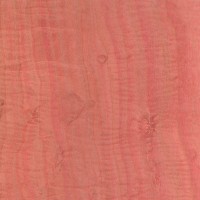 |
Common Name(s): Pink Ivory, Red Ivorywood Scientific Name: Berchemia zeyheri Distribution: Southern Africa Tree Size: 100-130 ft (30-40 m) tall, 3-5 ft (1-1.5 m) trunk diameter Average Dried Weight: 65 lbs/ft3 (1,035 kg/m3) Specific Gravity (Basic, 12% MC): .90, 1.04 Janka Hardness: 3,230 lbf (14,370 N) Modulus of Rupture: 20,020 lbf/in2 (138.1 MPa) Elastic Modulus: 2,193,000 lbf/in2 (15.12 GPa) Crushing Strength: 11,630 lbf/in2 (80.2 MPa) Shrinkage: Radial: 4.8%, Tangential: 7.2%, Volumetric: 12.1%, T/R Ratio: 1.5 |
Color/Appearance: Pink Ivory ranges in color from a pale brownish pink, to a bright, almost neon pink, to a deep red. Typically the most valuable pieces of Pink Ivory are a vibrant pink. Pink Ivory can commonly be seen with a curly or fiddleback grain pattern, further enhancing its visual impact. Sapwood of Pink Ivory tends to be pale yellow to light brown, with a somewhat gradual demarcation from heartwood. Color changes in Pink Ivory (becoming faded or dull over time) can be problematic and are not fully understood.
Grain/Texture: Grain is straight to interlocked; fine, even texture with good natural luster.
Endgrain: Diffuse-porous; medium pores in no specific arrangement, nuymerous; commonly in radial multiples of 2-4; gum/heartwood deposits common, though not easily seen with lens; growth rings may be distinct due to increased pore frequency in earlywood; narrow to medium rays visible without lens; parenchyma not visible with lens.
Rot Resistance: Rated as durable to very durable regarding decay resistance, Pink Ivory is said to have excellent weathering characteristics: though it is seldom used in applications where this would be an issue.
Workability: Pink Ivory has a pronounced blunting effect on cutting edges, and it’s fairly difficult to work in board form. Tearout can occur on figured or quartersawn sections during planing. Pink Ivory is much more common in applications involving carving or turning, and it turns and finishes well.
Odor: Pink Ivory has a distinct and somewhat unpleasant odor when being worked.
Allergies/Toxicity: Besides the standard health risks associated with any type of wood dust, no further health reactions have been associated with Pink Ivory. See the articles Wood Allergies and Toxicity and Wood Dust Safety for more information.
Pricing/Availability: Reputed to be a scarce commodity, Pink Ivory is typically very expensive, usually on par with Gaboon Ebony: another pricey African import.
Sustainability: This wood species is not listed in the CITES Appendices or on the IUCN Red List of Threatened Species.
Common Uses: Carving, veneers, inlay, knife handles, billiard cues, chessmen, and other turned objects.
Comments: Pink Ivory trees are said to be both rare and valuable, and have been rumored to be “rarer than diamonds.” Other reports state that the tree is relatively common in some areas of South Africa—though large trees with straight, defect-free trunks are much more scarce. According to folklore, the tree is considered sacred to the Zulus in South Africa and is reserved for royalty.
None available.
Scans/Pictures: The bright pink/red colors shown below represent what is usually the most sought-after hues of Pink Ivory. Also, you’ll see some Pink Ivory that has been turned into an ice cream scoop handle, and has been used in the Neapolitan pattern consisting of Black Walnut (chocolate), Hard Maple (vanilla), and Pink Ivory (strawberry).
 |
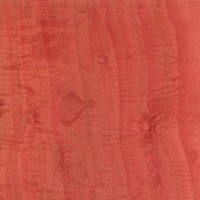 |
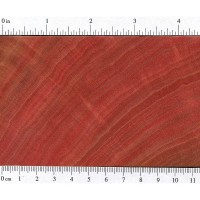 |
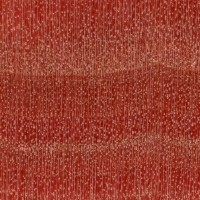 |
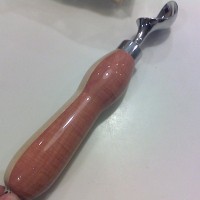 |
[iframe id=”https://www.youtube.com/embed/UvHEBMTv1aY?rel=0″]


A box in Pink Ivory
I was very fortunate in collecting a very old Stump used as a barricade in the gardens of our small community near Bela Bela, South Africa. It was very heavy indeed, I didn’t know what it was either. I soon found out that it was not going to be easy to saw down the middle of it by hand. I Had to find someone nearby to make the cut for me, so I did, only to have him tell me a few weeks later, after he managed to slice through, that he never experienced wood that hard in his life.… Read more »
Is it possible to bend pink ivory?
Yes. If it is thin enough. 1/8 and 1/16 veneer bends easily
Hey guys, can you help me please.
I was wondering how long it takes to grow this tree from a seed to a size that can be used for wood?
I had a fallen tree that I cut and noticed the beautiful inner color of the tree. Found another one growing on our property. Wondered what kind of tree it might be and the closest I could find is pink ivory, but the tree & bark look quite different. What do you think? Pink ivory or some other species?
Did the wood have a strong odor while cutting it? It looks like eastern red cedar to me.
Yes, I asked another friend who does cabinetry and he confirmed eastern red cedar also!
I didn’t notice any odor when cutting, but it had maybe been dead for a while.
Yestern red cedar for sure (Juniperus virginiana). Very good and important wood for making blocks in recorders. It has very nice and strong – like perfume- fragrance.
A turned bowl from pink ivory
Helloo!
Can someone help me unfortunately I couldn’t find any information about the brown ivory. I would be interested in its hardness and how it is related to pink ivory. thanks for the help.I want to make a wind instrument. :)
Talk about dulling effect. I sharpened my chisel before turning this and by the time I knocked the corners off I had to sharpen again because the wood kept wanting to catch fire. Honestly it was pretty difficult to turn compared to desert ironwood and African Blackwood, the latter of which is an absolute dreamboat on the lathe despite being harder than pink ivory. It says here that it doesn’t have any known health effects but I would be careful about the dust; I only breathed it in once and it made me sneeze a bunch and my nose all… Read more »
I had the same experience (janka 3230 !!!). This wood forced a switch to the Robert Sorby Turnmaster (one tool, 3 interchangeable carbide tips) – yes you need a diamond- coated “credit card” to sharpen them, but it’s EASY. Those carbide cutters went through the pink ivory with no difficulty – what a pleasure.
Hope this helps !
I turned some ivorywood for the first time today but will avoid it in future. It really was hard work, took a long time and dulled my tools very quickly. I then sanded it on the lathe with only the dust extractor on but forgot my mask, and must have inhaled some dust which has left me with a headache and feeling a little nauseous. The finished piece looks superb but I didn’t enjoy working with it and will choose some easier wood for my next project.
I may have a few large pieces of this, it’s so pink I thought maybe it had been dyed/sprayed pink! Is this in fact pink ivory?
Can you attach pics?
Here it is;
That doesn’t look like pink ivory. The pink coloration almost looks like a discoloration in the wood somehow, and not the natural heartwood color.
I’ve bought a fair bit of pink ivory, and hate to disagree with Eric, but your wood looks exactly like many photos of pink ivory offered by Cook Woods, and others. The pink color can be VIBRANT – unfortunately it fades quite a bit to brown over time, and I’ve never found a solution to that.
I wasn’t doubting the ID based on the vibrancy of the color. I was basing it off of: 1) The piece looks enormous, almost like a 4×4 construction timber. I think the odds of someone randomly having several very large, apparently rough-sawn pieces of pink ivory are very, very low. 2) The color is not consistent. If you look at the original image provided, about 1/4 the way down, you’ll notice a tiny defect in the wood, and the surrounded area is a lighter color lacking the pink. This suggests that it’s some sort of discoloration and not the true… Read more »
I understand- how might he determine this, definitively, given that wood’s value ?
Take a closeup picture of the endgrain.
How about lightly sanding or planing a small section of it to see if the colour gets more vibrant or disappears?
I have very similar in colour pieces of … old pear wood.
The wood does take a high polish with very fine sandpaper but will darken with age to more of a reddish brown.
I found a large bole at a garage sale. It had a lot of checking and had to take about an inch off all around. I filled the checks with several applications of thin cyanoacrylate and that worked well. Nice smell when working.
Very cool wood carving you’ve done there.
Great Sculpture!
Hello, It’s a beautiful carving you have there but the (above) description for this wood, Pink Ivory, states that it ought to have an unpleasant odor while working with it. Also, your example is awfully red (not in an awful sense… to the contrary, it’s, seemingly, a perfect & HIGHLY desirable red color). I believe there is a chance you are working with some type rosewood…. or, padauk because of the sheer redness of it. Personally, I love working with padauk because of its sweet, almost cinnamon+nutmeg-like aroma. Also, I could be wrong. However, my experience, here, with the “‘database”… Read more »
Hi Erick,
I have this sample that was thought to be B. zeyheri but I am wondering if it may actually be B. discolor (brown ivory). the end grain is similar (I do not have a proven pink ivory sample to compare though). As you can see in the sample it is not pink and this has been sanded (it is also finished with coats of blonde shellac. The end grain has also been finished but you might be able to see the anatomical features
Hard to say, is there any odor when you sand the raw wood? Do you have an idea as to the weight of the piece?
I do not recall any scent when sanding.
The sample stands at 0,91 g/cm3 (MC unknown)
. Mmmmm, Does look VERY simular to Dalbergia Nitidula (Purplewood flat bean) when oxidised.
I’m sanding down a couple of chairs and they are light pink; hence the reason I googled this wood color. Should I not paint them? Is the wood worth something?
The chances are overwhelmingly that the chairs are not made of pink ivory. Do you have pictures of the raw wood? It still might be something worth preserving.
Hello .I am in Turkey. I have such a tree. Is this tree pink ivory?
First off, thanks for getting a good and clear picture of the endgrain, it’s very helpful. That doesn’t look like pink ivory to me. Not only just the color, but also on the endgrain, I can see banded parenchyma, appearing possibly as marginal parenchyma, which pink ivory lacks.
Hi.I have polished new photos.The tree is as heavy as iron. Compared to a tree of the same size. unknown wood 0.61 lb , lignum vitea 0.49 Ib.
You mentioned you were in Turkey, correct? Was this wood imported, or on a locally grown tree? Are you sure that the moisture level of both of those woods have reached equilibrium when comparing them?
This tree was imported from south africa I know it has been kept dry for about 20 to 30 years.And lignum vitea 20 to 30 years.The dryness levels are the same.I have one of this unknown wood.Lignum vitea I have 160 pieces.It was a reserved material for the yacht.
Okay, the bit about coming from South Africa is a very helpful bit of information to know. I think I was confused because you are calling it a “tree” but I think you just mean “wood” or “log” — so maybe exact meaning is getting lost in translation. Maybe someone from South Africa can chime in here if they recognize it.
yes translation error :) ‘wood’ . yes someone can know in south africa
And oh ja! I am from that place South Africa……. In that case, then i am quite “almost certain”, you sir have purple wood flat bean right there. Small shrub, true rosewood, and it doesnt really give of a overwhelming sweet scent when working with it.
Flower of Zimbabwe!
Its actually quite wide spread in Africa…… Also called Zebra wood in West Africa, Nigeria and many other names.
I know my camera work is a bit crappy, but it does look very similar to Dalbergia Nitidula……will search for some decent photos
.
Unknown wood
Bubinga.
Really???!!! Is it true this wood species is not listed in the CITES Appendices or on the IUCN Red List of Threatened Species?
I need to confirm this formation please.
It’s true. However, I should clarify that there’s a difference between IUCN evaluating a species and determining it is “least concern” and simply not evaluating a species. It may be that pink ivory is too obscure of a species to focus much attention on, so it has simply not investigated it yet. Also, CITES determines international trading, particularly with source countries that may have a problem with compliance and enforcement. It may be that South Africa is doing their own enforcement and preservation of the species.
I have made a beautiful large coffee table, mirror and TV cupboard from a red ivory tree stamp dropped by someone in my yard because it was in their way. Had the stump cut up in planks. Definitely a wood worthy of being called a royal wood, more beautiful than polished iron wood and rivals tamboti.
I am having limited success growing Berchemia zeyheri from seed in Southern Arizona. At 5 years old, the bottom 6 inches is only as thick as a broom handle, and will only be sapwood for about 20 years. At 4 years, it produced its first flowers and viable seeds. It does not like frost, but will probably stand the desert winters once it is old enough to have thick bark. Ground squirrels gnaw the bark off saplings..I have been keeping them potted, and bringing indoors through the winters. It keeps its leaves over the winter indoors..
Thank you for your information, I find it very interesting. Can you explain a bit more what does frost make to these trees?
That was so awesome and is the 1st time I’ve ever seen that Wood in my life; it is beautiful, glorious thank you for sharing and for being so kind in your explanation of the Wood.
Hello Robert: I tried for years to get Berchemia zeyheri to germinate, using different “drastic” methods which included even using petri dishes with the hard shells carved down to reveal the embryos. However, I did get them to begin to germinate, but they died before really sprouting. I have a friend who lives in Thailand, and he tends to be almost negligent and reckless in the way in which he approaches things. So, I sent him some of B.zeyheri and B.discolor seeds (Which I have never been able to get to germinate.). So, upon arrival at his home in Thailand… Read more »
Olá Bob, moro no Estado de Rondônia, Brasil. Há três anos e meio adquiri uma muda da berchemia zeheri de um site chamado Planta Mundo . Meu interesse é variar o pomar. Pelo q li a frutinha é gostosa. Poderia me descrever o sabor da frutinha? A minha está com cerca de 2metros de altura.
Can I have some seeds of Berchemia zeheri ? Would you like to trade or exchange some seeds from South East Asia.
Portland is too vastly different from Thailand…. closest you’ll get in USA will probably be Florida, and even then it might be hopeless
Made a comb out of this wood recently. Sanded the surface up to 2000 grit, the surface feels like glass, and looks fantastic even without a finishing coat. Definitely tricky to cut thin slices of this wood without getting a “tear-out” as mentioned. I broke a tooth on the comb but super glue fixed this seamlessly -probably because the wood is very dense and hard.
Love working with Pink Ivory, just made a pen/stylus combo for my daughter about 2 hours ago. So far I have only turned Pink Ivory so I have no experience in working with it other than turning. Given the dimensions Pink Ivory is generally available in, inlays, turning or carving is about all it is suitable for. I not only like the look of Pink Ivory, it has a really good feel to it when it’s nicely polished up.
Just turned some Pink Ivory on the lathe. Turns beautifully; tight, dense grain that polishes well. The shavings and spindle were the color bubble gum, pencil eraser or Pepto-Bismol.
Not experienced with this wood, wanted to make a tobacco pipe from a piece, have heard some woods are toxic in this regard, was hoping for some information. Thanks Dan
Toxicity should be minimal, as the color is derived from tannin. The density should help it from charring thru like softer woods, but you might have to be clever and line it with a briarwood dowel, bored out.
It’s probably not as harmful as what’s being smoked, should be ok.
I have worked with this wood and it is a ***** to work with…
The grain is very sharp and pointy and interlocked… This wood can bend in small sliver live crazy. It is the most non-straight grain to work with ever!!! Fair warning: Ammonia will bleach the pink color out of this wood…
If you want to see a masterpiece, do a search on Amazon for Dennis Capplinger’s Gospel Banjo book. The banjo on the cover has a solid pink ivory wood neck, and the resonator is maple with pink ivory veneer on top. Quite striking. The neck wood came from Eisenbrand Exotic Hardwoods back when Art was in charge; the veneer was from Certainly Wood. It sounds as awesome as it looks.